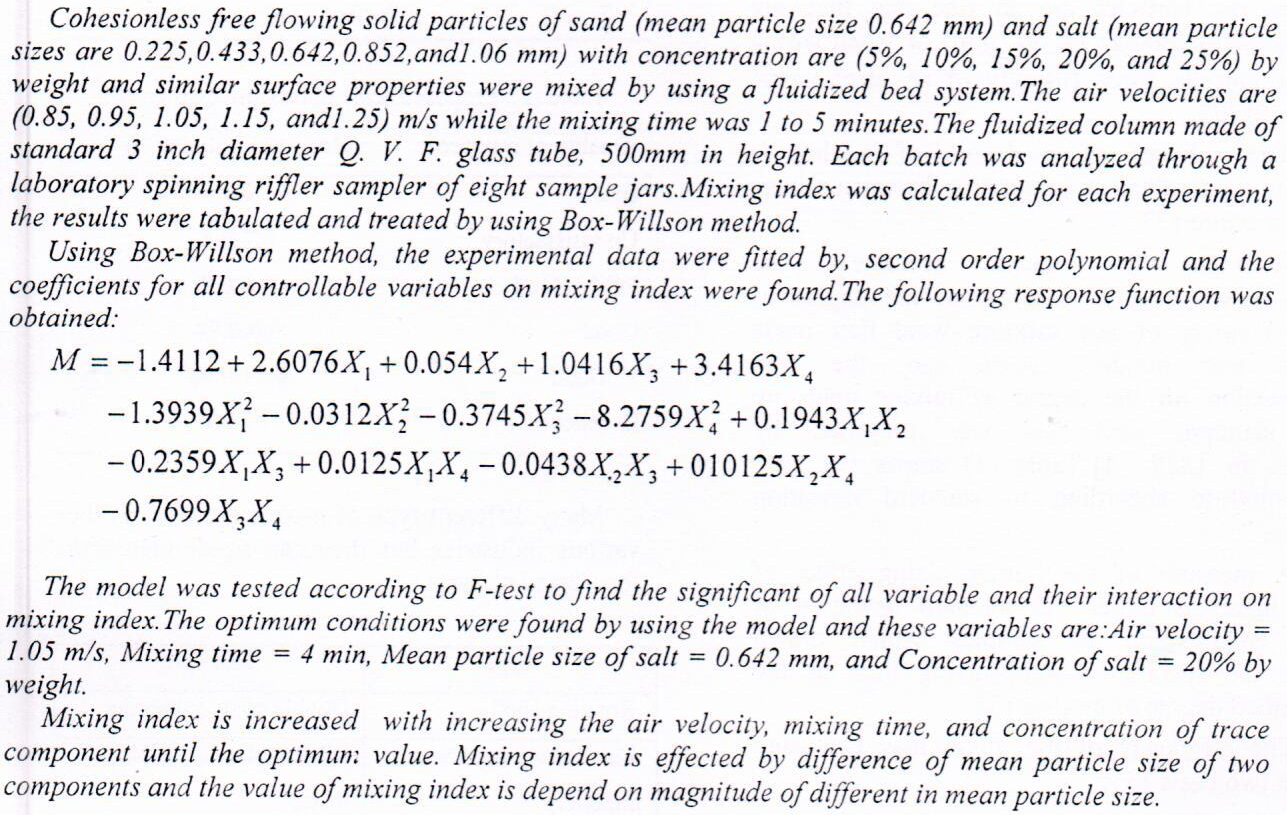
 (1)
(1)
 (1)
(1)
Solid dispersion (SD) is one of the most widely used methods to resolve issues accompanied by poorly soluble drugs. The present study was carried out to enhance the solubility and dissolution rate of Aceclofenac (ACE), a BCS class II drug with pH-dependent solubility, by the SD method. Effervescent assisted fusion technique (EFSD) using different hydrophilic carriers (mannitol, urea, Soluplus®, poloxamer 188, and poloxamer 407) in the presence of an effervescent base (sodium bicarbonate and citric acid) in different drug: carrier: effervescent base ratio and the conventional fusion technique (FSD) were used to prepare ACE SD. Solubility, dissolution rate, Fourier transformation infrared spectroscopy (FTIR), PowderX-ray diffraction
... Show More (5)
(5)
 (3)
(3)
 (8)
(8)
 (7)
(7)
In this research the hard chromium electroplating process, which is one of the common methods of overlay coating was used, by using chromium acid as source of chromium and sulphuric acid as catalyst since the ratio between chromic acid and sulphuric acid is (100 : 1) consequently. Plating process was made by applying current of density (40 Amp / dm2) and the range of solution temperature was (50 – 55oC) with different time periods (1-5 hr). A low carbon steel type (Ck15) was used as substrate for hard chromium electroplating. Solid carburization was carried out for hard chromium plating specimen at temperature (925oC) with time duration (2 hr) to be followed with quenching and tempering
... Show MoreRecently, many materials have shown that they can be used as alternatives to chemicals materials in order to be used to improve the properties of drilling fluids. Some of these materials are banana peels and corn cobs which both are considered environmentally- friendly materials. The results of the X-ray diffraction examination have proved that the main components of these materials are cellulose and hemicellulose, which contribute greatly to the increasing of the effectiveness of these two materials. Due to their distinct composition, these two materials have improved the rheological properties (plastic viscosity and yield point) and reduced the filtration of the drilling fluids to a large extent. The addition rates used for each o
... Show More (5)
(5)
A theoretical analysis of mixing in the secondary combustion chamber of ramjet is presented. Theoretical investigations were initiated to insight into the flow field of the mixing zone of the ramjet combustor and a computer program to calculate axisymmetric, reacting and inert flow was developed. The mathematical model of the mixing zone of ramjet comprises differential equations for: continuity, momentum, stagnation enthalpy, concentration, turbulence energy and its dissipation rate. The simultaneous solution of these equations by means of a finite-difference solution algorithm yields the values of the variable at all internal grid nodes.
The results showed that increasing air mass flow (0.32 to 0.64 kg/s) increases the development o
One of the troublesome duties in chemical industrial units is determining the instantaneous drop size distribution, which is created between two immiscible liquids within such units. In this work a complete system for measuring instantaneous droplet size is constructed. It consists of laser detection system (1mW He-Ne laser), drop generation system (turbine mixer unit), and microphotography system. Two immiscible liquids, water and kerosene were mixed together with different low volume fractions (0.0025, 0.02) of kerosene (as a dispersed phase) in water (as a continuous phase). The experiments were carried out at different rotational speed (1180- 2090 r.p.m) of the turbine mixer. The Sauter mean diameter of the drops was determined by la
... Show MoreReactive Powder Concrete (RPC) can be incorporate as a one of the most important and progressive concrete technology. It is a special type of ultra-high strength concrete (UHSC) that’s exclude the coarse aggregate from its constitutive materials. In this research an experimental study had been carried out to investigate the effect of using three types of materials (porcelain aggregate) and others sustainable materials (glass waste and granular activated carbon) as a partial replacement of fine aggregate. Four percentages had considered (0, 10, 15 and 20) % to achieve better understanding for the influence of these materials upon the compressive strength of RPC. Four curing ages had included in this study, these are; 7, 28, 60 and
... Show More (7)
(7)
Reactive Powder Concrete (RPC) can be incorporate as a one of the most important and progressive concrete technology. It is a special type of ultra-high strength concrete (UHSC) that’s exclude the coarse aggregate from its constitutive materials. In this research an experimental study had been carried out to investigate the effect of using three types of materials (porcelain aggregate) and others sustainable materials (glass waste and granular activated carbon) as a partial replacement of fine aggregate. Four percentages had considered (0, 10, 15 and 20) % to achieve better understanding for the influence of these materials upon the compressive strength of RPC. Four curing ages had included in this study, these are; 7, 28, 60 and
... Show More (6)
(6)
 (7)
(7)
